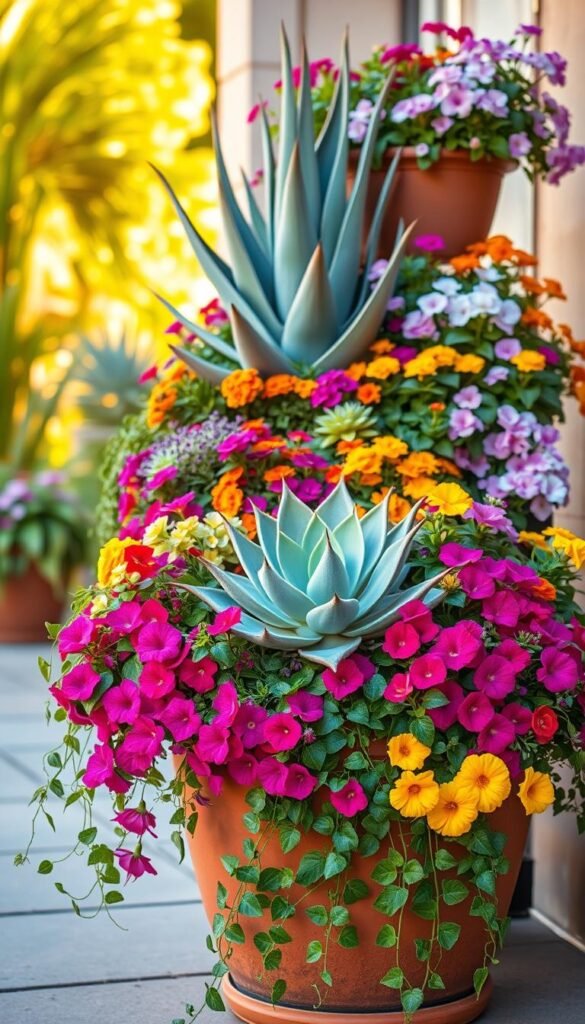Imagine turning your patio or balcony into a vibrant oasis bursting with color and texture. With strategic combinations of plants in thoughtfully chosen planters, you can craft eye-catching displays that evolve with every season. This approach lets you experiment with heights, leaf shapes, and blooming patterns without needing permanent garden beds.
Recent studies show designs using varied planter sizes increase perceived space by 40%, perfect for urban dwellers. By maximizing small spaces through vertical setups, you’ll create depth while keeping maintenance manageable. The secret lies in balancing trailing vines with upright specimens and filler foliage for year-round appeal.
You’ll soon discover how professional-looking results come from understanding plant relationships. Pair sun-loving varieties with similar water needs, or mix contrasting textures like spiky succulents with soft ferns. Pro tip: Rotate your creations monthly to ensure even growth and prevent leggy stems.
Whether you’re working with ceramic pots or modern troughs, these mobile ecosystems let you refresh your outdoor style effortlessly. Start with three key elements—thrillers, fillers, and spillers—then watch your living artwork thrive!
Introduction: Transforming Your Outdoor Space with Containers
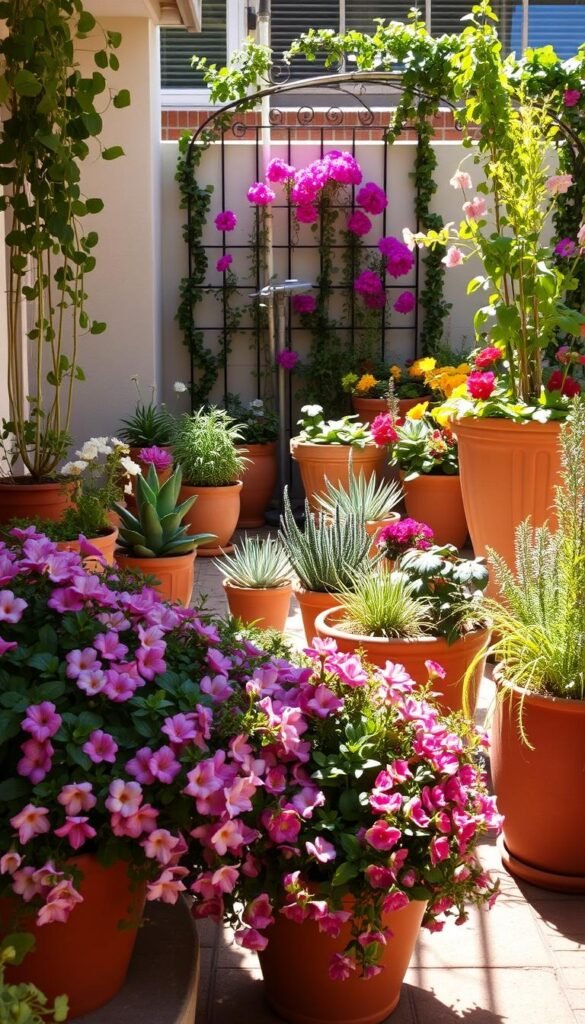
Breathe new life into outdoor areas by arranging pots that blend beauty and practicality. With container gardening, even a compact patio becomes a canvas for creativity. You control every detail—from soil mixtures to sunlight exposure—without digging up your yard.
Why choose containers? They let you redefine layouts weekly or seasonally. Renters love this flexibility, but homeowners also appreciate how pots protect delicate plants during frosts. A study by Urban Greening Journal found movable gardens extend growing seasons by 3-6 weeks in temperate zones.
| Feature | Container Gardening | Traditional Beds |
|---|---|---|
| Flexibility | Rearrange anytime | Fixed location |
| Space Use | Vertical & horizontal | Ground-only |
| Soil Control | Custom blends | Native soil |
Strategic placement matters. Cluster three pots near seating areas to frame views. Elevate trailing varieties on shelves to guide eyes upward, making tight spaces feel airy. Pair vibrant blooms with textured grasses for contrast.
Your patio gains personality through experimentation. Try tropical themes with elephant ears one summer, then switch to drought-tolerant succulents. Containers empower you to adapt as trends—or your tastes—evolve.
Understanding the Fundamentals of Container Gardening
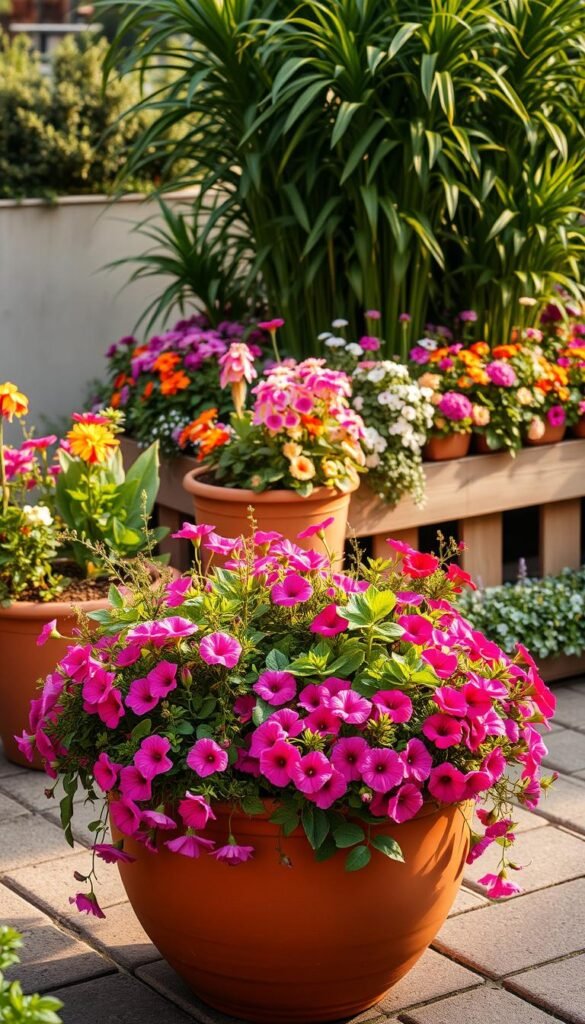
Ever wonder why some plant groupings look effortlessly stunning while others feel chaotic? The secret lies in three core principles: balance, proportion, and contrast. These elements transform random plants into cohesive displays that captivate the eye.
Creating Visual Harmony
Balance acts like an invisible scale in your container. Symmetrical designs mirror plants on both sides for formal elegance—think matching geraniums flanking a central fountain grass. Asymmetrical setups feel more relaxed, pairing bold elephant ears with airy ferns of equal visual weight.
Scaling Your Elements
Proportion ensures your arrangement doesn’t overwhelm its space. A 24-inch planter needs taller specimens than a 10-inch pot. Match root depth to vessel height—deep containers suit tomatoes, while shallow bowls work for succulents. This relationship keeps plants healthy and displays proportionate.
Contrast adds drama through opposites. Pair spiky yucca with round coleus leaves. Combine velvet-textured sage with glossy begonias. Even color plays a role—deep purple heuchera makes yellow marigolds pop. These differences create movement in your design.
Test your creations by circling them. Do they hold interest from all angles? Adjust trailing vines or rotate pots until every view feels intentional. With practice, you’ll instinctively craft arrangements that feel both dynamic and stable.
Selecting the Ideal Containers and Planters
Your choice of vessels makes all the difference between thriving greenery and lackluster results. The right planters enhance your space’s aesthetics while supporting healthy root systems and growth patterns. Let’s explore materials that balance practicality with visual appeal.
Exploring Fiberglass and Other Durable Options
Fiberglass pots revolutionize container gardening through weather-resistant performance. Unlike terracotta that cracks in frost or ceramic that chips easily, these lightweight warriors withstand decades of sun, rain, and temperature swings. Their textured finishes mimic natural materials while offering modern durability.
Why choose fiberglass? You can rearrange your containers effortlessly—even when filled with soil. One study showed gardeners save 30% effort moving planters compared to stone or concrete alternatives. The non-porous surface prevents water loss, meaning you’ll hydrate your plant less frequently.
Consider these features when shopping:
- Integrated drainage holes to prevent root rot
- UV-resistant coatings for color retention
- Insulating layers protecting roots from heat spikes
Pair sleek rectangular containers with modern architecture or choose urn-shaped pots for classic charm. Pro tip: Match planter depth to your species’ root size—shallow bowls for herbs, deeper vessels for shrubs.
Designing with Layered Arrangements for Visual Depth
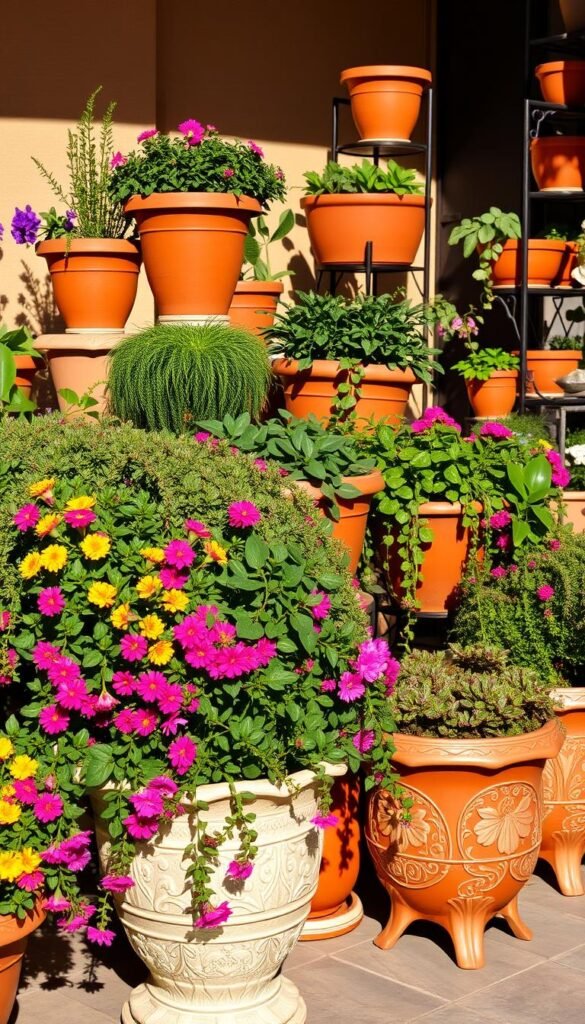
Transform your outdoor displays into living sculptures with strategic plant layering. By stacking greenery at varying heights, you craft depth that tricks the eye into seeing more space. This technique works wonders on balconies, patios, or even windowsills.
Techniques for Layering Taller, Mid, and Trailing Plants
Start with a bold focal point – maybe a spiky dracaena or flowering hibiscus. Surround it with mid-height plants like coleus or begonias. Finish with spillers that tumble over edges, such as ivy or creeping jenny. This trio creates instant drama.
Try these pro tips for success:
- Rotate containers weekly to prevent plants from leaning toward light
- Pair fast-growing foliage with slow-spreading varieties
- Use adjustable plant stands to experiment with elevation
Smart move: Track sun patterns before planting. Light-loving specimens belong where they’ll thrive, not where they’ll cast shadows on shade-preferring neighbors. This prevents leggy growth and keeps your design balanced.
Seasonal swaps keep displays fresh. Replace spring pansies with summer petunias, then autumn mums – all while maintaining your layered structure. Trailing plants like sweet potato vine anchor the look year-round, their cascading stems bridging seasonal transitions.
Potted Flower Garden: Layered Arrangements for Lush Container Displays
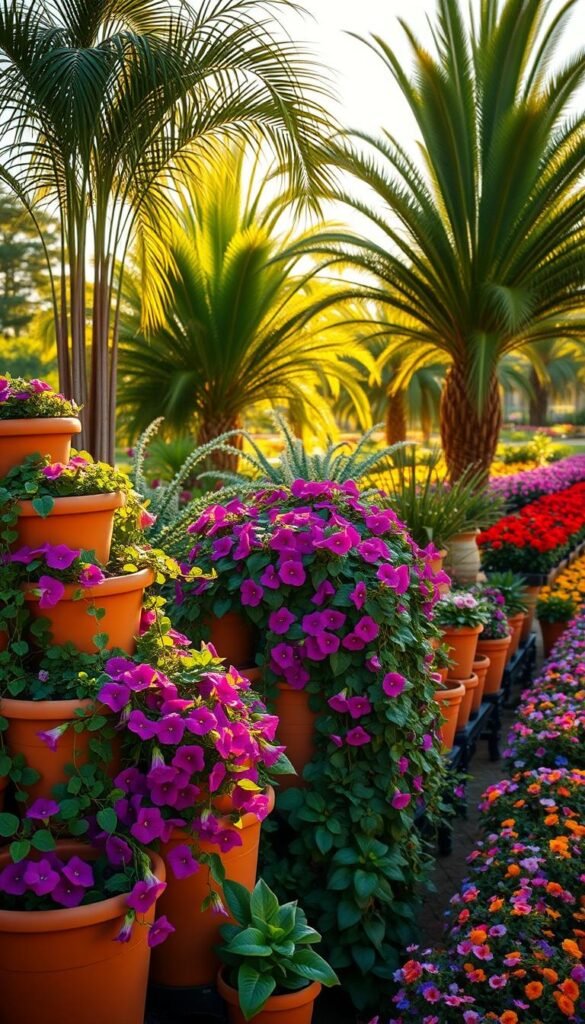
Elevate your space with the thriller, filler, spiller formula—a blueprint professional designers use to craft showstopping displays. This approach gives your container garden instant structure while letting your personality shine through plant choices. “The magic happens when each element plays its role,” notes landscape designer Mara Hoffman. “Your thriller commands attention, fillers build depth, and spillers soften edges.”
Start with a bold centerpiece like red canna lilies or spiky cordyline. Surround them with medium-height bloomers—calibrachoa or dusty miller work beautifully. Finish with cascading lobelia or ivy to create flowing movement. These three tiers ensure visual interest from every angle, whether your arrangement sits on a patio table or hangs from a railing.
Plan for year-round appeal by mixing plants with staggered bloom times. Pair early-spring pansies with summer-blooming geraniums and autumn sedum. This strategy keeps your flowers vibrant through seasons without constant replanting. Remember: matching water and light needs matters more than color coordination alone.
Test your design by stepping back 10 feet. Does the composition hold its shape? Squint—if elements blur together, add contrasting textures. A velvety sage beside glossy begonias adds intrigue, while ornamental grasses offset rounded blooms. Your container becomes a living sculpture that evolves daily, rewarding careful planning with endless charm.
Choosing the Right Plants for Color and Texture
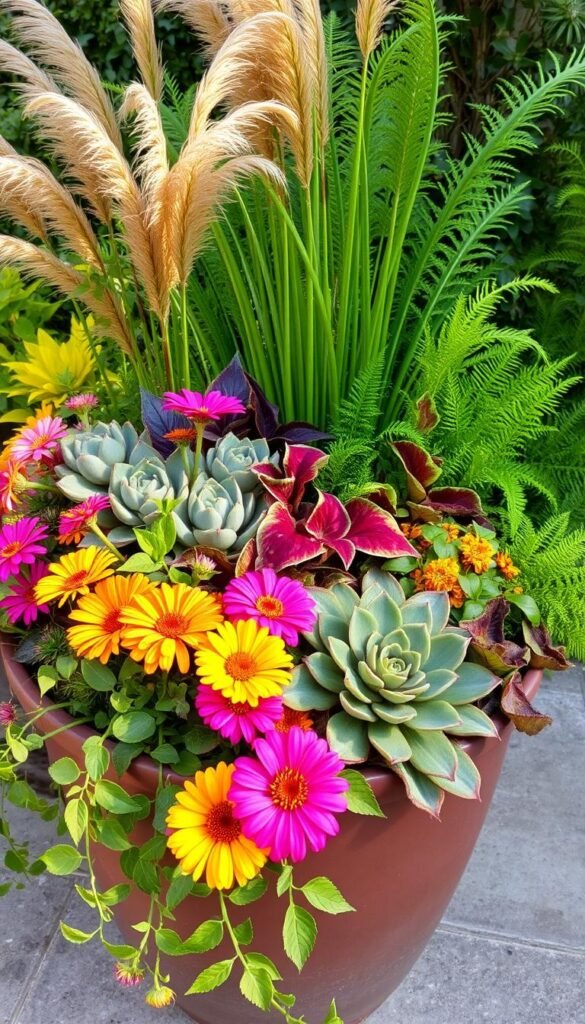
The secret to eye-catching planters lies in pairing blooms and leaves that play off each other’s strengths. Start by selecting spring stars like tulips and daffodils for early vibrancy, then layer in pansies for sustained color. Flowers provide the wow factor, while foliage acts as your design’s backbone.
Using Vibrant Flowers and Lush Foliage
Think beyond bloom hues. Silver dust miller makes purple petunias pop, while chartreuse sweet potato vine brightens deep red geraniums. Combine spiky lavender with round-faced marigolds for textural intrigue. This contrast keeps arrangements lively without chaos.
Seasonal planning ensures nonstop appeal. Hyacinths and primrose shine in spring, while zinnias take summer’s heat. Come fall, swap in mums paired with ornamental kale. Always include evergreen herbs like rosemary for structure when blooms fade.
| Season | Flower Picks | Foliage Partners |
|---|---|---|
| Spring | Tulips, Daffodils | Heuchera, Ferns |
| Summer | Petunias, Zinnias | Coleus, Sage |
| Fall | Mums, Sedum | Kale, Ornamental Grass |
Pro tip: Use the color wheel as your guide. Pair complementary shades like orange marigolds with blue lobelia for drama. Analogous schemes—think pink geraniums beside coral begonias—create harmony. Your plants become paintbrushes; the planter your canvas.
Integrating Sweet Potato Vine and Trailing Plants
Sweet potato vine offers more than just color—it’s a design powerhouse. These vigorous growers create instant drama with their cascading stems, available in chartreuse, deep purple, and bronze varieties. Their drought tolerance makes them ideal for low-maintenance displays that stay lush during dry spells.
| Variety | Foliage Color | Perfect Pair |
|---|---|---|
| Marguerite | Bright Lime | Purple Petunias |
| Blackie | Deep Purple | White Alyssum |
| Sweet Caroline | Bronze-Red | Yellow Marigolds |
Position your potato vine at planter edges where stems can spill freely. Space plants 10-12″ apart to prevent overcrowding. Pro tip: Pair purple varieties with silver-leaved companions for moonlight garden effects.
These trailing plants serve dual roles—they soften container edges while unifying color schemes. Golden Lysimachia offers similar benefits if you prefer delicate yellow blooms over bold foliage.
For seasonal success, dig up tubers before frost. Store in peat moss at 50-60°F, then replant when soil warms. Take 6″ stem cuttings in spring for easy propagation—they’ll root in water within days.
Planting Techniques: Thriller, Filler, and Spiller Concepts
Creating dynamic plant groupings starts with understanding three key roles. Think of your container as a stage where each performer has a specific part. The thriller takes center spotlight, fillers build supporting depth, and spillers add motion with cascading energy.
How to Structure Your Plant Groupings
Choose a bold thriller like purple fountain grass or elephant ears. These vertical elements grab attention instantly. Surround them with medium-height fillers—try coleus or begonias—to create lush layers without overshadowing the star.
Complete the look with spillers that soften edges. Sweet potato vine or ivy work perfectly, spilling over your container’s rim. This trio ensures balance while letting each plant shine in its role.
Rotate your arrangement weekly for even growth. Pair plants with similar light and water needs to keep maintenance simple. With this formula, you’ll craft displays that feel intentional yet effortlessly vibrant.

